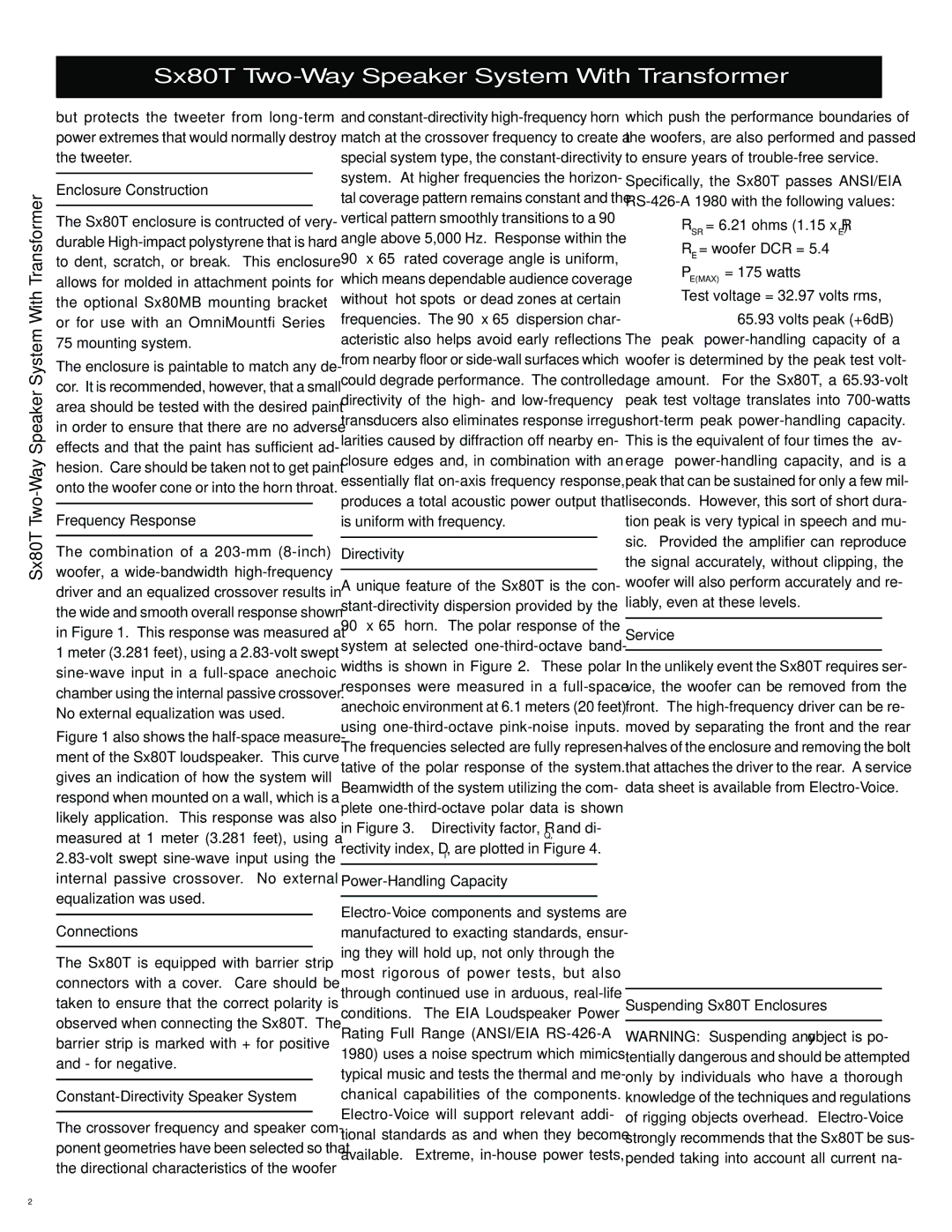Sx80T Two-Way Speaker System With Transformer
but protects the tweeter from long-term power extremes that would normally destroy the tweeter.
Enclosure Construction
The Sx80T enclosure is contructed of very- durable High-impact polystyrene that is hard to dent, scratch, or break. This enclosure allows for molded in attachment points for the optional Sx80MB mounting bracket or for use with an OmniMount® Series 75 mounting system.
The enclosure is paintable to match any de- cor. It is recommended, however, that a small area should be tested with the desired paint in order to ensure that there are no adverse effects and that the paint has sufficient ad- hesion. Care should be taken not to get paint onto the woofer cone or into the horn throat.
Frequency Response
The combination of a 203-mm (8-inch) woofer, a wide-bandwidth high-frequency driver and an equalized crossover results in the wide and smooth overall response shown in Figure 1. This response was measured at 1 meter (3.281 feet), using a 2.83-volt swept sine-wave input in a full-space anechoic chamber using the internal passive crossover. No external equalization was used.
Figure 1 also shows the half-space measure- ment of the Sx80T loudspeaker. This curve gives an indication of how the system will respond when mounted on a wall, which is a likely application. This response was also measured at 1 meter (3.281 feet), using a 2.83-volt swept sine-wave input using the internal passive crossover. No external equalization was used.
Connections
The Sx80T is equipped with barrier strip connectors with a cover. Care should be taken to ensure that the correct polarity is observed when connecting the Sx80T. The barrier strip is marked with + for positive and - for negative.
Constant-Directivity Speaker System
The crossover frequency and speaker com- ponent geometries have been selected so that the directional characteristics of the woofer
and constant-directivity high-frequency horn match at the crossover frequency to create a special system type, the constant-directivity system. At higher frequencies the horizon- tal coverage pattern remains constant and the vertical pattern smoothly transitions to a 90° angle above 5,000 Hz. Response within the 90° x 65° rated coverage angle is uniform, which means dependable audience coverage without “hot spots” or dead zones at certain frequencies. The 90° x 65° dispersion char- acteristic also helps avoid early reflections from nearby floor or side-wall surfaces which could degrade performance. The controlled directivity of the high- and low-frequency transducers also eliminates response irregu- larities caused by diffraction off nearby en- closure edges and, in combination with an essentially flat on-axis frequency response, produces a total acoustic power output that is uniform with frequency.
Directivity
A unique feature of the Sx80T is the con- stant-directivity dispersion provided by the 90° x 65° horn. The polar response of the system at selected one-third-octave band- widths is shown in Figure 2. These polar responses were measured in a full-space anechoic environment at 6.1 meters (20 feet) using one-third-octave pink-noise inputs. The frequencies selected are fully represen- tative of the polar response of the system. Beamwidth of the system utilizing the com- plete one-third-octave polar data is shown in Figure 3. Directivity factor, RQ, and di- rectivity index, Di, are plotted in Figure 4.
Power-Handling Capacity
Electro-Voice components and systems are manufactured to exacting standards, ensur- ing they will hold up, not only through the most rigorous of power tests, but also through continued use in arduous, real-life conditions. The EIA Loudspeaker Power Rating Full Range (ANSI/EIA RS-426-A 1980) uses a noise spectrum which mimics typical music and tests the thermal and me- chanical capabilities of the components. Electro-Voice will support relevant addi- tional standards as and when they become available. Extreme, in-house power tests,
which push the performance boundaries of the woofers, are also performed and passed to ensure years of trouble-free service.
Specifically, the Sx80T passes ANSI/EIA RS-426-A 1980 with the following values:
RSR = 6.21 ohms (1.15 x RE)
RE = woofer DCR = 5.4
PE(MAX) = 175 watts
Test voltage = 32.97 volts rms,
65.93 volts peak (+6dB) The “peak” power-handling capacity of a woofer is determined by the peak test volt- age amount. For the Sx80T, a 65.93-volt peak test voltage translates into 700-watts short-term peak power-handling capacity. This is the equivalent of four times the “av- erage” power-handling capacity, and is a peak that can be sustained for only a few mil- liseconds. However, this sort of short dura- tion peak is very typical in speech and mu- sic. Provided the amplifier can reproduce the signal accurately, without clipping, the woofer will also perform accurately and re- liably, even at these levels.
Service
In the unlikely event the Sx80T requires ser- vice, the woofer can be removed from the front. The high-frequency driver can be re- moved by separating the front and the rear halves of the enclosure and removing the bolt that attaches the driver to the rear. A service data sheet is available from Electro-Voice.
Suspending Sx80T Enclosures
WARNING: Suspending any object is po- tentially dangerous and should be attempted only by individuals who have a thorough knowledge of the techniques and regulations of rigging objects overhead. Electro-Voice strongly recommends that the Sx80T be sus- pended taking into account all current na-

